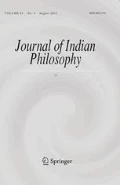Abstract
There are good reasons to think that Vāsudeva, Saṃkarṣaṇa, Pradyumna and Aniruddha already form a sort of implicit tetrad in the HV. The aim of this paper is to draw attention to often overlooked data related to this tetrad. (1) Upon first reading, the sequence of the HV episodes appears to be somewhat disconnected, and might lead one to conclude that no such grouping of these figures had as of yet taken place. Nevertheless, a closer look at the structure of the text makes it clear that these four characters are one of the main focuses of the narrator’s interest. (2) The relationships of these four heroes to one another and to other deities will be examined. In addition to their close kinship, these heroes with the exception of Aniruddha, are also said to be incarnations of other entities; thus the logic underpinning this grouping must be located at this other level. (3) Considered against the backdrop of the entire HV, one realizes that a basic pattern is established in which the presence of the goddess, under various names and functions, is required not only to facilitate Saṃkarṣaṇa’s and Kr̥ṣṇa’s births and actions on earth, but also the actions of Pradyumna and Aniruddha. In fact, neither Kr̥ṣṇa Vāsudeva, nor Saṃkarṣaṇa, nor Pradyumna nor Aniruddha can act entirely independently of her assistance. (4) The HV does not employ the word vyūha in connection with the group of Vāsudeva, Saṃkarṣaṇa, Pradyumna and Aniruddha. Nevertheless, during the battle waged to deliver Aniruddha, the idea of vyūha is present even if the word itself is not. HV 110.47–49 describes a true trivyūha composed of three fighters (Vāsudeva, Saṃkarṣaṇa and Pradyumna), who are arranged in such a way as to protect one another. The episode of Aniruddha’s liberation appears to be the missing link, showing clearly that at least Kr̥ṣṇa, Saṃkarṣaṇa and Pradyumna are capable of assuming a vyūha as they fight the Rudraic forces.
Similar content being viewed by others
References
BhP Bhāgavata-Purāṇa. (1971). Srimad Bhāgavatamahāpurāṇa (with Sanskrit Text and English Translation), Part I & II. Gorakhpur : Gita Press.
Couture, A. (1986). Akrūra et la tradition Bhāgavata selon leHarivaṃśa, Studies in Religion / Sciences Religieuses, 15(2), 221–232.
Couture, A. (1991). L’enfance de Krishna. Traduction des chapitres 30 à 78 [du Harivamsha] (é d.cr.). Paris, Les Éditions du Cerf; Québec : Les Presses de l’Université Laval.
Couture, A. (2003). Dvārakā: The making of a sacred place. In P. Granoff & K. Shinohara (Eds.), Pilgrims, patrons, and place: Localizing sanctity in Asian Religions, (pp. 225–248). Vancouver Toronto: University of British Columbia.
Couture, A. (2004a). Noteworthy resemblances between Pradyumna’s childhood and Kr̥ṣṇa’s Childhood. In M. Deshpande (Ed.), Problems in vedic and Sanskrit literature, (pp. 79–86). Delhi: New Bharatiya Book Corporation.
Couture, A. (2004b). Kr̥ ṣṇa’s victory over Bāṇa and goddess Koṭavī’s manifestation in the Harivaṃśa. Journal of Indian Philosophy, 31, 593–620.
Couture, A. & Schmid, C. (2001), The Harivaṃśa, the goddess Ekānaṃś ā, and the Iconography of the Vr̥ ṣṇi Triads. Journal of the American Oriental Society, 121(2), 173–192.
Gonda, J. (1970). Viṣṇuism and ś ivaism. A comparison. London: The Athlone Press, University of London.
Gupta, S. (1971). The Caturvyūha and the Viś ākha-yūpa in the Pāñcarātra. The Adyar Library Bulletin, 35(3–4), 189–204.
Hopkins, E. W. (1972). The social and military position of the ruling caste in ancient India as represented by the Sanskrit Epic. Varanasi: Bharat-Bharati (1st published 1889).
HV. (1936). Harivaṃś a-parvan, Vol. 7 of The Mahābhāratam. Edited by Pandit Ramchandrashastri Kinjawadekar with Nī lakaṇṭ ha’s commentary Bhāratabhāvadīpa. Poona: Chitrashala Press.
HV. (1969). The Harivaṃś a. Being the Khila or Supplement to the Mahābhārata. For the first time critically edited by P. L. Vaidya. Vol. I. Introduction, Critical Text and Notes. Poona: Bhandarkar Oriental Research Institute.
HV. (1971). The Harivaṃśa. Being the Khila or Supplement to the Mahābhārata. For the first time critically edited by P. L. Vaidya. Vol. II. Appendices. Poona: Bhandarkar Oriental Research Institute.
Jaiswal, S. (1981). The origin and development of Vaiṣṇavism. Delhi: Munshiram Manoharlal, 2nd revised and enlarged edition.
Matsubara, M. (1994). Pāñcarātra Saṃhitās and early vaiṣṇava theology. Delhi: Motilal Banarsidass.
MBh. (1973, 1975, 1978). The Mahābhārata. Vol.I. 1. The Book of the Beginning; Vol. II. 2. The Book of the Assembly Hall, and 3. The Book of the Forest; Vol. III. 4. The Book of Viraṭa, and 5. The Book of the Effort. Translated and Edited by J. A. B. van Buitenen. Chicago / LondoṇThe University of Chicago Press.
MBh. (1929–33). The Mahābhāratam. Edited by Pandit Ramchandrashastri Kinjawadekar with Nī lakaṇṭ ha’s commentary Bhāratabhāvadīpa. Poona: Chitrashala Press.
MBh. (1933–66). The Mahābhārata. Critically edited by V. S. Sukthankar and S. K. Belvalkar. 19 Volumes.
NP. The Nārāyanīyaparvan of the ś āntiparvan of the MBh. See MBh (1929–33), MBh (1933–66).
Schrader, F. O. (1973). Introduction to the Pāñcarātra and the Ahirbudhnya Saṃhitā. Madras: The Adyar Library and Research Centre, (1st ed. 1916).
Srinivasan, D. M. (1981). Early Krishna Icons: The Case at Mathurā. In J. G. Williams (Ed.), Kalādarśana: American studies in the art of India (pp. 127–136). Leiden: Brill.
ViP. (1989). The Viṣṇu Purāṇa. Text and Translation by H. H. Wilson (1940, reedition 1980; reprint 1989). Delhi: Nag Publishers.
Author information
Authors and Affiliations
Corresponding author
Rights and permissions
About this article
Cite this article
Couture, A. The emergence of a group of four characters (Vāsudeva, Saṃkarṣaṇa, Pradyumna, and Aniruddha) in the Harivaṃśa: points for consideration. J Indian Philos 34, 571–585 (2006). https://doi.org/10.1007/s10781-006-9009-x
Accepted:
Published:
Issue Date:
DOI: https://doi.org/10.1007/s10781-006-9009-x




